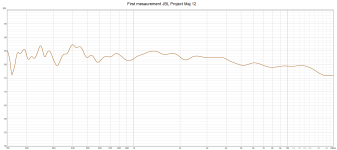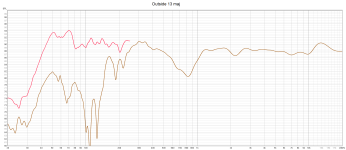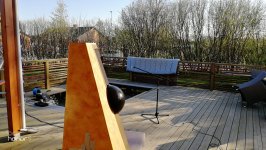Just want to ask you experiance people.
Whats the "most" honest/correct metod/way to mesaure when you use a big 15 inch driver from 150-600 hz, and have 44 cm between lowmid and midrange (600-7000 hz) , and also 28 cm up to tweeter ( 7K and up) ?
So i have 72 cm from center 15 inch lowmid up to center "tweeter".
obviously I can't measure from 1 meter & have the microphone between center treble and center mid range ( as i use to)
Is 2 meter enough and should i put the microfone between the tweeter and lowmid?
Best regards John
Whats the "most" honest/correct metod/way to mesaure when you use a big 15 inch driver from 150-600 hz, and have 44 cm between lowmid and midrange (600-7000 hz) , and also 28 cm up to tweeter ( 7K and up) ?
So i have 72 cm from center 15 inch lowmid up to center "tweeter".
obviously I can't measure from 1 meter & have the microphone between center treble and center mid range ( as i use to)
Is 2 meter enough and should i put the microfone between the tweeter and lowmid?
Best regards John
Attachments
It makes the most sense to measure on the listening axis. That is where I'd locate the mic in elevation. Being a floor standing design you are pretty much locked in for height. As far as the distance goes, the farther away you are more room interaction will get included in the measurement. Doing the measurements outdoors would be the best as far as accuracy is concerned.
It makes the most sense to measure on the listening axis. That is where I'd locate the mic in elevation. Being a floor standing design you are pretty much locked in for height. As far as the distance goes, the farther away you are more room interaction will get included in the measurement. Doing the measurements outdoors would be the best as far as accuracy is concerned.
Okey thanks.
Speaker is 150 kilo each but i try with a heavy duty transport wagon.
Sadly i also have a road 20 meters from my garden, but will try 👍.
Still mic at about 2 meters?
Regards John
Measuring has some rules, OK. On the other side, you are not doing this for a living.
So what you measure will have a meaning only for you. Before dragging these 300kg around, maybe tell us what you want to see in these measurements.
Usually I would measure between high and mid once and the same between mid and low. About 1m away. Then merge both curves where you find them identical. Most measuring programs can do this.
So what you measure will have a meaning only for you. Before dragging these 300kg around, maybe tell us what you want to see in these measurements.
Usually I would measure between high and mid once and the same between mid and low. About 1m away. Then merge both curves where you find them identical. Most measuring programs can do this.
Measuring has some rules, OK. On the other side, you are not doing this for a living.
So what you measure will have a meaning only for you. Before dragging these 300kg around, maybe tell us what you want to see in these measurements.
Usually I would measure between high and mid once and the same between mid and low. About 1m away. Then merge both curves where you find them identical. Most measuring programs can do this.
Okey, even if its 72 cm center lowmid-tweeter?
This was in my room yesterday, mic at 90 cm 2,7 meter from speaker.
But ask´t for i don´t know from "where" i should mesaure.
Listeningpossition, at 1 m as usual, 2-3 meters ???
Regards John
Attachments
I would place the microphone at sitting ear height (about 44"/1.1m) above the floor (where your ears will mostly be when listening to them anyway), and check to see if that height is approximately half-way between the midrange and tweeter driver apertures. If it's high or low from the centerline between the two drivers, then split the difference up or down between the initial height and the centerline height.
Then I'd place a lot of absorption material on the floor between the microphone and the front of the loudspeaker, at least 1 inch/2.5 cm thick and about 2 m wide. The microphone should be at 1 m from the front baffle. The more absorption you use, the better the phase/group delay measurements will be.
If you can, I'd try to remove any all-pass phase shifts between the drivers if you are using DSP crossover by dialing in appropriate delays on the higher frequency drivers--and remove any near field acoustic reflectors within 1-2 m (40-80 inches) from either the loudspeakers themselves or the listening position(s).
Explanation for the above:
The phase of the higher frequency drivers will always lead the lower frequency drivers, so the precedence effect will strongly favor the higher frequency arrivals, i.e., you will perceive the center of the loudspeaker at the tweeter/midrange height, not at the centroid of the loudspeaker's drivers.
In order to measure phase response accurately, you need to remove early reflections from the floor and nearby room furnishings/walls, hence the absorption on the floor from the loudspeaker to the microphone and 2 m wide.
As the frequency gets lower and lower, closer to the room's Schroeder frequency (approximately 100-200 Hz for most rooms that can handle that size loudspeaker), the beamwidth broadens rapidly, thus negating any advantage to putting the measurement microphone nearer the centerline of the drivers. The radial distance of the lower frequency drivers to the 1m nearfield microphone position will straighten out to be about the same distance to the listening position--relative to the higher frequency drivers.
In the crossover interference bands, you will measure a great deal of variation of SPL vs. both vertical and horizontal microphone positions, so just being on-axis with the measurement microphone is the best bet. Get used to it--or trade in your loudspeakers for coaxial MEHs... The closer together you can get the drivers, the more realistic the sound field from all aspects of listening to them in-room. Having to have your head in a vise is the antithesis of good sound quality, I've found.
Chris
Then I'd place a lot of absorption material on the floor between the microphone and the front of the loudspeaker, at least 1 inch/2.5 cm thick and about 2 m wide. The microphone should be at 1 m from the front baffle. The more absorption you use, the better the phase/group delay measurements will be.
If you can, I'd try to remove any all-pass phase shifts between the drivers if you are using DSP crossover by dialing in appropriate delays on the higher frequency drivers--and remove any near field acoustic reflectors within 1-2 m (40-80 inches) from either the loudspeakers themselves or the listening position(s).
Explanation for the above:
The phase of the higher frequency drivers will always lead the lower frequency drivers, so the precedence effect will strongly favor the higher frequency arrivals, i.e., you will perceive the center of the loudspeaker at the tweeter/midrange height, not at the centroid of the loudspeaker's drivers.
In order to measure phase response accurately, you need to remove early reflections from the floor and nearby room furnishings/walls, hence the absorption on the floor from the loudspeaker to the microphone and 2 m wide.
As the frequency gets lower and lower, closer to the room's Schroeder frequency (approximately 100-200 Hz for most rooms that can handle that size loudspeaker), the beamwidth broadens rapidly, thus negating any advantage to putting the measurement microphone nearer the centerline of the drivers. The radial distance of the lower frequency drivers to the 1m nearfield microphone position will straighten out to be about the same distance to the listening position--relative to the higher frequency drivers.
In the crossover interference bands, you will measure a great deal of variation of SPL vs. both vertical and horizontal microphone positions, so just being on-axis with the measurement microphone is the best bet. Get used to it--or trade in your loudspeakers for coaxial MEHs... The closer together you can get the drivers, the more realistic the sound field from all aspects of listening to them in-room. Having to have your head in a vise is the antithesis of good sound quality, I've found.
Chris
So, why are you measuring? For what purpose? If you are not developing a speaker for general sale, how they measure as an isolated unit is perhaps not so important. After all, you place them where you want them and measure them in this location. If you would like to make sure that each "way" is behaving correctly wrt. FR and distortion, measure each "way" closely (5 cm?) and if OK, move back to your listening position and use proper gating suitable for EQ the whole system - I assume you have access to proper EQ...
//
//
I would place the microphone at sitting ear height (about 44"/1.1m) above the floor (where your ears will mostly be when listening to them anyway), and check to see if that height is approximately half-way between the midrange and tweeter driver apertures. If it's high or low from the centerline between the two drivers, then split the difference up or down between the initial height and the centerline height.
Thank you so much Cask05 for your clear explanation 🙂
Use to have as much absorption material on the floor as i have to use, and try to absorbe some of the sides to.
My ears is about 91 cm from the floor when i sitt in my sofa
I have two 16 ohm driver and two 8 ohm driver in this 4 way, so trickey xover-thinking, and i have never built a 4 way before.
Regards John
So, why are you measuring? For what purpose? If you are not developing a speaker for general sale, how they measure as an isolated unit is perhaps not so important. After all, you place them where you want them and measure them in this location. If you would like to make sure that each "way" is behaving correctly wrt. FR and distortion, measure each "way" closely (5 cm?) and if OK, move back to your listening position and use proper gating suitable for EQ the whole system - I assume you have access to proper EQ...
Hallo TNT
I have never use EQ or other "built in" room calibration functions, because i wants to have as few "elements" between source and speaker as possible.
And always try to use "the own quality " of the speaker/drivers/xovers in it self, and get the best of it.
And the "charm of it all" goes away a little, when you totaly changes the drivers own "sound" i think.
Of course if you allready have mediocre/bad drivers at home and wants to build a DIY speaker, then its unother thing.
I measure both to know where im at with the xover, and to tweak the xover and also to learn more about it all.
And it would be real nice to "learn" what kind of SPL curve you generally prefer in speakers.
Regards John
It shouldn't matter since the aim is to take in the complete power picture. As a result, any effort you put into making this decision would be well spent improving your measurement scheme in general.should i put the microfone between the tweeter and lowmid?
It will space you better from the cabinet, but it will put you further into the room thereby raising your lower frequency limit.Is 2 meter enough
Hard to try to mesaure outside on my porch with cars comming all the time, and the neighbor started running a pressure washer hahaha.
Also a floor/wood at the place, but here are 2 mesaurements.
One is from woofer mesaured from mic 50 cm, and the other from 1 meter mic in front of tweeter at 121 cm high.
Tweeter is JBL 2405h and "work" from about 7000 hz.
A deep dip at 800 hz, but have not see it before ?
Regards John
Also a floor/wood at the place, but here are 2 mesaurements.
One is from woofer mesaured from mic 50 cm, and the other from 1 meter mic in front of tweeter at 121 cm high.
Tweeter is JBL 2405h and "work" from about 7000 hz.
A deep dip at 800 hz, but have not see it before ?
Regards John
Attachments
I'd employ whatever that is draped over the railing back there. Lay it on the deck in front of the loudspeaker and remeasure at the appropriate height .. your listening axis.
Is there any way you can raise the whole loudspeaker up? .. table .. chair?
Is there any way you can raise the whole loudspeaker up? .. table .. chair?
Last edited:
I'd employ whatever that is draped over the railing back there. Lay it on the deck in front of the loudspeaker and remeasure at the appropriate height .. your listening axis.
Is there any way you can raise the whole loudspeaker up? .. table .. chair?
Its impossible it weight 150 kilo.
Had to take in the speaker inside again over night, its night here in Sweden and weather is unreliable.
The lowmid sits only 30 cm from "floor", so center 15 inch lowmid is 48 cm.
Regards John
Calculate the floor...
Can you explain how to calculate that Allen ?
Regards John
Maybe have measurement axis over that pit to reduce floor bounce?
Damn, i not think of that!
It should have been better for sure.
(the pit is after a large bubbelpool, and not so nice to have now)
Regards John
Calculate the floor
800 hz wavelength is 43 cm, 15 inch lowmid is 48 cm from "floor" in the center begain at 30 cm ends at 68 cm.
Is it that ?
So if measuring distance is 1 meter, height of driver cc 48 cm and microphone is 121 cm up, .
344/1+1,22-1 = 343,48 ? ( something is missing there, math is not my best strength at this level)
And what is "half wave frequency" ?
50% of 800 hz in my case?
Regards John
344/1+1,22-1 = 343,48 ? ( something is missing there, math is not my best strength at this level)
And what is "half wave frequency" ?
50% of 800 hz in my case?
Regards John
Last edited:
- Home
- Loudspeakers
- Multi-Way
- How to measure a 4 way with "big" distance between drivers?



